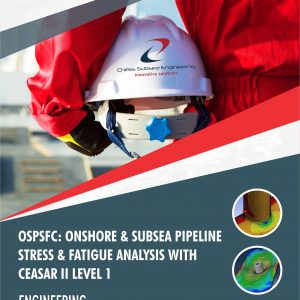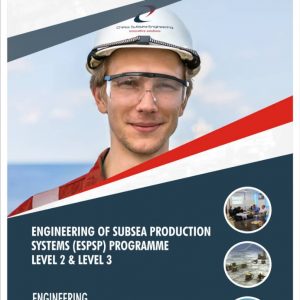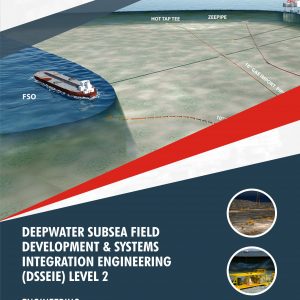Description
Deepwater Offshore & Subsea Field Flow Assurance Engineering (DOSFAW) is a comprehensive training program designed to equip engineers with the knowledge and skills necessary to ensure the safe and efficient flow of oil and gas in deepwater offshore and subsea fields. The course is divided into two levels, Level 1 and Level 2, each focusing on different aspects of flow assurance engineering.
Level 1: The DOSFAW Level 1 course serves as an introduction to flow assurance engineering. Participants learn the fundamental principles and concepts related to flow assurance in deepwater and subsea environments. This includes understanding fluid properties, thermodynamics, flow behavior, pipeline design, and production chemistry. The course also covers key challenges specific to deepwater operations, such as hydrate formation, wax deposition, and erosion.
Level 2: Building upon the foundation established in Level 1, DOSFAW Level 2 delves into more advanced topics in flow assurance engineering. This includes in-depth studies of multiphase flow, hydrate management, wax and asphaltene deposition, and other complex phenomena. The course emphasizes problem-solving strategies and provides real-world case studies to enhance participants’ ability to design and implement effective flow assurance strategies.
Both levels of the DOSFAW course place a strong emphasis on practical applications and industry best practices. Engineers learn how to analyze and address flow assurance challenges through a combination of theoretical instruction, hands-on exercises, and interactive discussions. The courses are designed to provide participants with a comprehensive understanding of flow assurance concepts and equip them with the skills needed to optimize production and mitigate risks in deepwater offshore and subsea fields.
Deepwater Offshore & Subsea Field Flow Assurance Engineering (DOSFAW) Level 1 & Level 2 covers Subsea Fields i.e. Types of Fields, Engineering Phases e.g.Feasibility / Concept Phases, Front End Engineering Design (FEED) phase, Operation, Tail End Production / Increase Oil (Gas) Recovery (IOR), Main Flow Assurance Challenges in System Design Fluid Properties, Pipe Flow, Hest Transfer, Hydrates i.e. Hydrate Control Strategy, Hydrate Prevention, Hydrate Control Remediation etc. Flow Induced Vibration & Fatigue, Wax, Erosion i.e. Causes of Erosion, Cavitation, Erosion Corrossion, Sand Production and Erosion due to Produced Sand and more
DOSFAW Level 1 & Level 2 is designed to provide detailed knowledge of Deepwater Subsea Field Development & Systems Integration Engineering and will assist those who are switching or enhancing there career in deep and ultra deepwaters subsea engineering.
Course Outline
- Types of Field
- Engineering Phases e.g. Feasibility /Concept Phases, Front End Engineering Design (FEED) phase, Operation,
- Tail End Production / Increase Oil (Gas) Recovery (IOR)
- Main Flow Assurance Challenges in System Design
- Fluid Properties
- Pipe Flow
- Heat Transfer
- Multiphase Flow Regimes
- Multiphase Sluggings
- Hydrate Control Strategy
- Hydrate Prevention
- Hydrate Control Remediation
- Flow Induced Vibration & Fatigue
- Causes of Erosion
- Cavitation
- Erosion Corrossion
- Sand Production and Erosion due to Produced Sand
Technical Support References
Ref 1: Overview of flow assurance in offshore oil and gas production
Ref 2: Importance of flow assurance for ensuring uninterrupted production
Ref 3: Fluid properties and their effect on flow assurance
Ref 4: Flow regime and flow assurance challenges
Ref 5: Flow assurance modeling and simulation techniques
Ref 6: Identifying and assessing flow assurance risks
Ref 7: Risk management techniques and flow assurance mitigation strategies
Ref 8: Introduction to operational excellence and process safety management
Ref 9: Overview of subsea production systems
Ref 10: Flow assurance issues specific to subsea production systems
Ref 11: Subsea flowline and riser design considerations for flow assurance
Ref 12: Formation of hydrates and their impact on production
Ref 13: Hydrate management techniques and technologies
Ref 14: Hydrate prevention and remediation strategies
Ref 15: Formation of wax and asphaltene deposits and their impact on production
Ref 16: Wax and asphaltene management techniques and technologies
Ref 17: Wax and asphaltene prevention and remediation strategies
Ref 18: Corrosion mechanisms and their impact on subsea production systems
Ref 19: Corrosion monitoring and mitigation strategies
Ref 20: Introduction to cathodic protection and chemical inhibition
Ref 21: Formation of scale deposits and their impact on production
Ref 22: Scale management techniques and technologies
Ref 23: Scale prevention and remediation strategies
Ref 24: Overview of pipeline pigging and inspection
Ref 25: Types of pipeline pigs and their functions
Ref 26: Pipeline inspection technologies and techniques
Ref 27: Overview of project management principles and methodologies
Ref 28: Applying project management to flow assurance
Ref 29: Project risk management, scheduling, and cost estimation for flow assurance projects
Assessment
Participant underpinning knowledge of engineering of deepwater subsea control systems architecture & umbilical will be accessed with short answer multiple-choice questionnaire at the conclusion of the course.
Outcome
Participants will gain an in debt understanding of Deepwater Offshore & Subsea Field Flow Assurance Engineering along with flow assurance management. They will also be able to function with minimum supervision as a Subsea Engineer for IOCs, subsea pipeline company contractor, vendor or installation company.
Professional Certificate
Issued directly by Chess Subsea Engineering Europe.
Participant may be presented for Offshore Petroleum Training Organization (OPITO) Certification.
How to Register
Click here to download registeration booklet on msword and email completed booklet to info@chesssubseaengineering.org directly.










